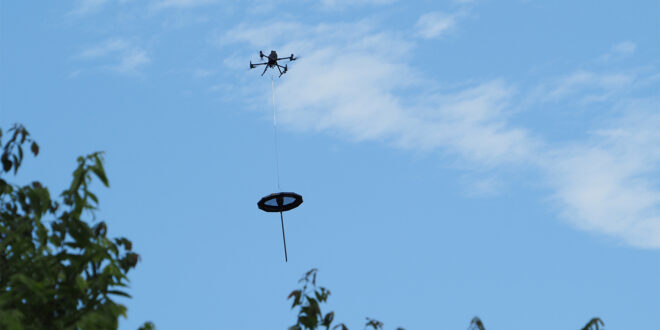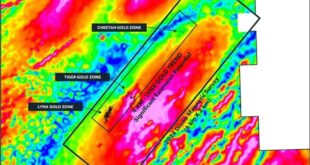- The collection of DNA samples with the assistance of drones and robots was a recurring theme at the semifinals of a $10 million competition to identify automated rainforest conservation solutions.
- At least half of the 13 teams used drones and robots to retrieve genetic samples left behind by wildlife on tree canopies, water and air.
- As the field of environmental DNA, or eDNA, evolves, there’s rising interest in using automated technology to collect samples from difficult terrain.
- While limitations continue to exist, scientists say they’re hopeful that the gaps will be filled as the field of eDNA continues to grow.
SINGAPORE — A huge drone hums and hovers above the canopy of a tree. Just as one might start to think that the show is over, the action begins.
Slowly, a robotic arm with a sheet of sampling paper attached at the end drops down from the drone. On reaching the canopy, the arm rubs the paper against the vegetation repeatedly.
Over the next hour, ETH BiodivX — a team of scientists, artificial intelligence experts and drone pilots from Switzerland — launches two more drones at Windsor Nature Park in Singapore. One is fitted with a pump and filter to collect water from a stream in the forest, and the other flies above the canopy to collect air samples.
For all three, the end goal is a common one: collect DNA samples from the environment.
ETH BiodivX wasn’t alone in automating the collection of DNA samples. At the semifinals of a $10 million rainforest conservation technology competition, at least six out of the 13 competing teams used different iterations and combinations of robots and drones to facilitate DNA sampling from the forest. The five-year competition is organized by California-based nonprofit XPRIZE Foundation in a bid to identify technology that can help automate the assessment of rainforest biodiversity.
While a team from Brazil used robotic rovers to collect soil samples and leaf litter, another one from Belgium set up bait and traps on a robotic vehicle to collect insect excreta.
“Rainforest is a difficult environment to be in and we really have a hard time accessing what’s living in these spaces,” Kristy Deiner, assistant professor of environmental DNA at ETH Zurich and one of the three team leads for ETH BiodivX, told Mongabay. “Accessing these places and scaling up in a robust way so that you can do repeat sampling, that’s where it makes sense to come up with automation tools.”
Using the samples collected using the three drones, Deiner’s team identified species like tropical land snails (Quantula striata), Asian honey bees (Apis cerana) and Timonius wallichianus, a species of trees native to this part of Southeast Asia.
Environmental DNA, or eDNA, is the genetic material left behind by animals via their excreta, hair, saliva and fur. Scientists have long analyzed these samples to understand the biodiversity in forests, rivers, oceans, and even Mount Everest. While researchers praise the methodology for its ability to survey large areas and its non-invasive nature, collecting samples from difficult terrain, like rainforests and the deep ocean, remains a challenge. However, as was evident from the XPRIZE semifinals that took place in late May and early June, the evolution of eDNA analysis in recent years has sparked more interest in automated sampling.
“To be able to do autonomous sampling means you can extend your spatial and temporal observations in an affordable way,” Kelly Goodwin, a marine microbiologist with the U.S. government’s National Oceanic and Atmospheric Administration, who is not associated with the XPRIZE Foundation’s competition, told Mongabay. “It’s more nimble and flexible.”
Since the early 2000s, Goodwin has collaborated with a team at California-based nonprofit Monterey Bay Aquarium Research Institute that has engineered robots to collect aquatic DNA samples. A study she co-authored and published in the journal Environmental DNA in May 2022 documents how the team used autonomous underwater vehicles equipped with environment sampling processors to collect and filter seawater from remote areas of the deep ocean.
Over the years, Goodwin said, she has seen firsthand how the technology has developed, while making progress in small increments. While earlier prototypes could collect only five samples from the ocean, the current version of the instrument has the capability to collect around 60 samples.
“I think there is an explosion in interest now because the technology has actually matured,” she said. “We are starting to see a return on investment and the fruition of efforts put into research and technology for years.”
But it’s not all perfect yet.
For one, Goodwin said, the filtration system for aquatic sampling needs an upgrade. The regular filters currently in use are designed to throw away things trapped in them. However, for eDNA analysis, it’s the material on the filter that’s essential — as evidenced in a recent study that found air pollution sensors were inadvertently also trapping airborne DNA. Goodwin said getting DNA off the filter is still not an easy task.
“Here we have these super sexy and cool robots, but on the inside, it’s just a regular old filter,” Goodwin said. “It’s like the Flintstones’ car where their feet run the vehicle. Underneath, it’s not very fancy.”
There are larger issues within the eDNA analysis methodology that also need looking into.
Autonomous technology might make it easier to get more samples, but a universal reference library that will allow scientists to assign retrieved sequences to specific species is still lacking.
“Our biggest limitation is that we will have sequences, but we need a database to match,” Esther Lizano, senior researcher at the Institute of Evolutionary Biology in Barcelona, and a member of Team Providence Plus at the XPRIZE semifinals, told Mongabay. Lizano’s team used drones to drop umbrella-shaped data-gathering platforms on tree canopies and water surfaces; the platforms collect not just DNA samples but also acoustic data. “What I think is really necessary is more collaborations with local scientists where they can identify an animal or plant and then we sequence, and then introduce this data into a database.”
Scientists say they’re hopeful that these gaps will be filled in the years ahead, much like how sampling has made major advances.
“My holy grail fantasy is a vehicle that collects the DNA, processes it, sequences it and sends the sequencing back autonomously,” Goodwin said. “It sounds crazy but it’s not because people are already working on it.”
Banner image: An Asian honey bee (Apis cerana), one of the species Deiner’s team identified by using the DNA samples collected using drones. Image by Tetsuya Shimizu via Wikimedia Commons (CC BY 2.0).
Abhishyant Kidangoor is a staff writer at Mongabay. Find him on Twitter @AbhishyantPK.
Meet the tech projects competing for a $10m prize to save rainforests
Citations:
Lim, M. C., Seimon, A., Nightingale, B., Xu, C. C., Halloy, S. R., Solon, A. J., … Seimon, T. A. (2022). Estimating biodiversity across the tree of life on Mount Everest’s southern flank with environmental DNA. iScience, 25(9), 104848. doi:10.1016/j.isci.2022.104848
Truelove, N. K., Patin, N. V., Min, M., Pitz, K. J., Preston, C. M., Yamahara, K. M., … Chavez, F. (2022). Expanding the temporal and spatial scales of environmental DNA research with autonomous sampling. Environmental DNA, 4(4), 972-984. doi:10.1002/edn3.299
Littlefair, J. E., Allerton, J. J., Brown, A. S., Butterfield, D. M., Robins, C., Economou, C. K., … Clare, E. L. (2023). Air-quality networks collect environmental DNA with the potential to measure biodiversity at continental scales. Current Biology, 33(11), R426-R428. doi:10.1016/j.cub.2023.04.036
 Unmanned Aerial Vehicle The latest drone news
Unmanned Aerial Vehicle The latest drone news





